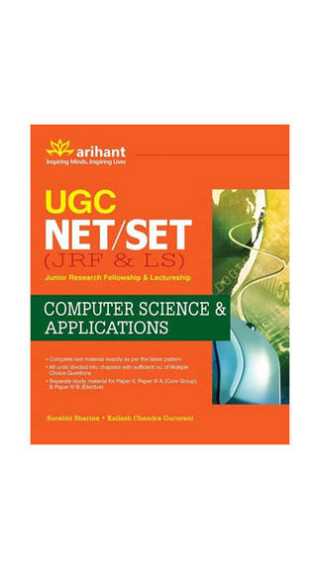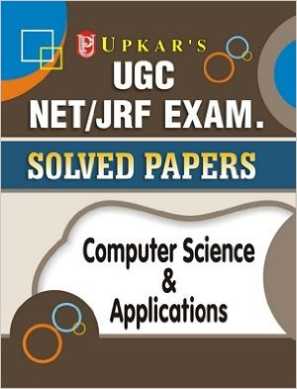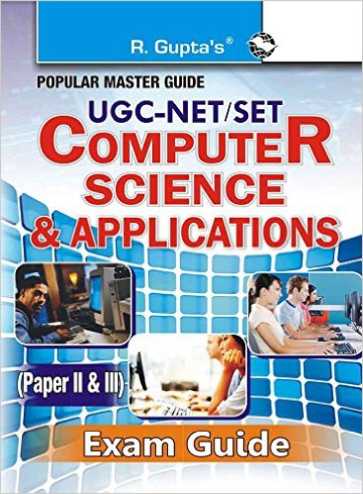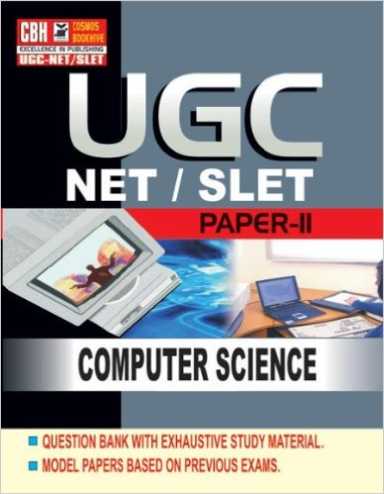|
#1
| |||
| |||
|
NET exam study material for computer science subject UGC, along with CSIR currently conducts NET for appointments of teachers in colleges and universities. It has made NET qualification mandatory for teaching at Graduation level and at Post Graduation level since July 2009. However, those with Ph.D are given five percent relaxation. Study Material: There are many subjects under Computer Science and it is not possible to provide the study material of all the subjects. So here I am mentioning the syllabus of the following subjects: Subjects under Computer Science: Artificial Intelligence (AI) Computer Arithmetic Computer Graphics (CG) Current Trends and Technologies DataBase Management Systems (DBMS) Data Communication and Networks Data Structures and Algorithms (DSA) Digital Systems and Microprocessors Discrete Structures (DS) Finite Automata and Formal Languages (FA) Information Theory and Coding Neural Networks and Fuzzy Systems Object Oriented Programming (OOP) Operation Research (OR) Operating Systems (OS) Programming Concepts Programming in C and C++ Software Engineering (SE) System Software and Compilers Teaching and Research Aptitude Unix Web Technologies Windows Syllabus: Artificial Intelligence Definitions. AI approach for solving problems Automated Reasoning with propositional logic and predicate logic- fundamental proof procedure, refutation. resolution, refinements to resolution (ordering/pruning/restriction strategies) State space representation of problems, bounding functions, breadth first, depth first, A, A*, AO*, etc. Performance comparison of various search techniques Frames, scripts, semantic nets, production systems, procedural representations. Prolog programming Components of an expert system, Knowledge representation and Acquisition techniques, Butlding expert system and Shell RTNS. ATNS, Parsing of Ambiguous CFG's. Tree Adjoining Grammars (TAGs). Systems approach to planning, Designing; Development, Implementation and evaluation of MIS Decision-making processes, evaluation of DSS, Group decision support system and case studies; Adaptive design approach to DSS development, Cognitive style in DSS, Integrating expert and Decision support systems Computer Arithmetic Propositional (Boolean), Predicate Logic, Well-formed-formulae (WFF), Satisfiability and Tautology Logic Families TTL, ECL and C-MOS gates. Boolean algebra and Minimization of Boolean functions, Flip-flops-types, race condition and comparison. Design of combinational and sequential circuits Representation of integers Octal, Hex, Decimal, and Binary. 2's complement and 1's complement arithmetic. Floating point representation Computer Graphics Display systems, Input devices, 2D Geometry, Graphic operations, 3D Graphics, Animation, Graphic standard, Applications Concepts, Storage Devices, Input Tools, Authoring Tools, Application. Files Current Trends and Technologies Parallel Computing Parallel, virtual machine(pvm) and message passing interface(mpi) libraries and calls. Advanced architectures. Today's fastest computers. Mobile Computing Mobile connectivity- Cells, Framework, Wireless delivery technology and switching methods, mobile information access devices, mobile data internetworking standards, cellular data communication protocols, mobile, computing applications. Mobile databases- protocols, scope, tools and technology. M-business. E-Technologies Electronic Commerce: Framework, Media Convergence of Applications, Consumer Applications, Organisation Applications. Electronic Payment Systems: Digital Token, Smart Cards, Credit Cards, Risks in Electronic Payment System, Designing Electronic Payment Systems. Electronic Data Interchange(EDI): Concepts, Applications, (Legal, Security and Privacy) issues, EDI and Electronic Commerce, Standardization and EDI, EDI Software Implementation. EDI Envelope for Message Transport, Internet-Based EDI. Digital Libraries and Data Warehousing: Concepts, Types of Digital documents, Issues behind document Infrastructure, Corporate Data Warehouses. Software Agents: Characteristics and Properties of Agents, Technology behind Software Agents (Applets, Browsers and Software Agents). Broadband Telecommunications: Concepts, Frame Relay, Cell Relay, Switched Multimegabit Data Service, Asynchronous Transfer Mode. Main concepts in Geographical Information Systems (GIS), E-cash, E-Business, ERP packages. Data Warehousing: Data Warehouse environment, architecture of a data warehouse methodology, analysis, design, construction and administration. Data Mining: Extracting models and patterns from large databases, data mining techniques, classification, regression, clustering, summarization, dependency modelling, link analysis, sequencing analysis, mining scientiiic and business data. Windows Programming Introduction to Windows programming-Win32, Microsoft Foundation Classes (MFC), Documents and views, Resources, Message handling in windows. Simple Applications (in windows) Scrolling, splitting views, docking toolbars, status bars, common dialogs. Advanced Windows Programming Multiple Document Interface (MDI), Multithreading. Object linking and Embedding (OLE). Active X controls. Active Template Library (ATL). Network programming. DataBase Management Systems This article has multiple issues. Please help improve it or discuss these issues on the discussion page. • Some topics can be expanded. • Topics may not be arranged properly. Relational Database Design E-R Diagrams and their transformation to relation design. Normalisation- 1NF, 2NF, 3NF and 4NF. Limitations of 4NF and BCNF SQL Data definition language(DDL), Data manipulation language(DML), Data control language (DCL) commands. Database objects like- Views, indexes, sequences , synonyms, data dictionary. Database Concepts. ER diagams, Data Models, Design of Relational Database, SQL and QBE, Query Processing and Optimisation, Centralised and Distributed Database, Security, Concurrency and Recovery in Centralised and Distributed Database Systems, Object Oriented Database Management Systems (Concepts, Composite objects. Integration with RDBMS applications), ORACLE Data Communication and Networks Data Communication Analog and Digital transmission, Asynchronous and Synchronous transmission, Transmission media, Multiplexing and Concentration, Switching techniques, Polling Networks Topologies, Networking Devices, OSI Reference Model, Protocols for (i) Data link layer, (ii) Network layer, and (iii) Transport layer, TCP/IP protocols, Networks security; Network administration Network Fundaments Local area Network (LAN), metropolitan Area Network(MAN), Wide area Network(WAN), Wireless Network, Inter Network Reference Model The OSI model, TCP/IP model Data Communication Channel capacity. Transmission media- Twisted pair, Coaxial cables, Fiber optic cables, Wireless transmission- radio, microwave, infrared and millimeter waves. Light wave transmission. Telephones- local loop, trunks, multiplexing, switching, narrowband ISDN, broadband ISDN, ATM, High speed LANS, Cellular radio Communication. satellite- Geosynchronous and low-orbit Internetworking Switch/Hub, Bridge, router, Gateways Concatahetsd virtual circuits, Tunneling, Fragmentation, Firewalls Routing Virtual circuits and datagrams, Routing algorithms, congestion control Network Security Cryptography- Public key, Secret Key. Domain Name System (DNS)- Electronics mail and worldwide web (WWW). The DNS Resource Records, Name Services. E-Mail Architecture and Servers Data Structures and Algorithms Data Structure Data, Information, Data structure, Simple and Composite structures. Array, List, Stack, Queue, Linked list, Tree, Binary tree, B-tree, Graph, Priority queue and heap File Strucure Field, record and file. Sequential, direct, index-sequential and relative files. Hashing, inverted lists and multi-lists. B trees and B+ trees Sorting and Searching Algorithms Sorting and Searching Algorithms, Analysis of Algorithms, Interpolation and Binary Search, Asymptotic notations-big ohm, omega and theta. Average case analysis of simple programs like finding of a maximum of n elements. Recursion and its systematic removal. Quicksort- Non-recursive implementation with minimal stack storage Design of Algorithms Design of Algorithms (Divide and Conquer, Greedy method, Dynamic programming, Back tracking, Branch and Bound). Lower bound theory. Non-deterministic algorithm Non-deterministic programming constructs. Simple non-deterministic programs. NP-hard and NP-complete problems Digital Systems and Microprocessors Logic Families TTL, ECL and C-MOS gates. Boolean algebra and Minimization of Boolean functions, Flip-flops-types, race condition and comparison. Design of combinational and sequential circuits Digital Systems Combinational Circuit Design, Sequential Circuit Design, Hardwired and Microprogrammed processor design, Instruction formats, Addressing modes, Memory types and organisation, Interfacing peripheral devices, Interrupts Microprocessors Microprocessor architecture, Instruction set and Programming (8085, P-III/P-IV). Microprocessor applications Discrete Structures Set, relation, Functions, Pigeonhole Principle, inclusion-Exclusion Principle, Equivalence and Partial orderings, elementary counting techniques, Probability, Measure(s) for Information and total information. Graph Definitions walks paths, trails, connected graphs, regular and bipartite graphs, cycles and circuits, tree and rooted tree, spanning trees, eccentricity of a vertex radius and diameter of a graph, central graphs, centers of a tree, Hamiltonian and Eulerian graphs, planar graphs Group Finite field and error correcting / detecting codes Propositional (Boolean), Predicate Logic, Well-formed-formulae (WFF), Satisfiability and Tautology Finite Automata and Formal Languages This article has multiple issues. Please help improve it or discuss these issues on the discussion page. • Some topics can be expanded. • Topics may not be arranged properly. Compatibility Model of computation-Finite Automata, Pushdown Automata, Non-determinism and NFS, DPDA and PDAs and languages accepted by these structure, Grammars languages, non compatibility and example of non computable problems Theory of Computation Formal language, Need for formal computational models, Non-computational problems, diagonal argument and Russel's paradox. Deterministic Finite Automaton Deterministic Finite Automaton (DFA), Non-deterministic Finite. Automaton (NFA). Regular languages and regular sets. Equivalence of DFA and NFA. Minimizing the number of states of a DFA. Non-regular languages. and Pumping lemma. Pushdown Automaton Pushdown Automaton (PDA), Deterministic Pushdown Automaton (DPDA), Non-equilvalence of PDA and DPDA. Context free Grammars Greibach Normal Form (GNF) and Chomsky Normal Form (CNF), Ambiguity, Parse Tree Representation of Derivations. Equivalence of PDA's and CFG's. Parsing techniques for parsing of general CFG's Early's, Cook-Kassami-Younger (CKY), and Tomita's parsing. Linear Bounded Automata (LBA) Power of LBA. Closure properties. Turing Machine (TM) One tape, multitape. The notions of time and space complexity in terms of TM. Construction of TM for simple problems. Computational complexity. Chomsky Hierarchy of Languages Recursive and recursively-enumerable languages. Last edited by Aakashd; May 29th, 2019 at 09:11 AM. |
|
#3
| |||
| |||
|
As you want to get the Study Materials of the NET Exam of Computer Science so here I am suggesting you the names of some best books of this exam # Arihant Publications UGC - NET / SET (JRF & LS) Computer Science & Applications  UGC NET/JRF Exam Solved Papers Computer Science & Applications Paperback – Dec 2013 by NA (Author)  UGC NET Computer Science (Paper II and III) Guide: Paper II & III (Popular Master Guide) Paperback – 2014 by Shamshur Rabb Khan (Author)  Computer Science Ugc Net Slet Paper 2 Paperback – 2014 by Sawtantar Singh (Author) 
__________________ Answered By StudyChaCha Member |